Grooming the pet Havanese
You may have heard that the Havanese is non-shedding. The reality is that all dogs shed to some degree. Some more, some less. While the Havanese does not traditionally shed as some breeds do, he certainly will lose some coat in the hair brush, and where he rubs against furniture or rolls on carpets etc. The Havanese looses coat similarly to how you lose your hair. The Havanese would perhaps more accurately be described as low shedding. Low or minimal shedding does not mean no-maintenance. Your Havanese will benefit from frequent grooming sessions several times a week. Routine grooming helps to keep your dog's skin, coat, teeth, gums and nails in peak condition. As well as generally improving your pet's overall appearance , grooming also provides you with an excellent opportunity to examine the skin and coat for early signs of problems such as parasites, foreign bodies, skin disorders, matts, growths and wounds. The procedure outlined here follows the recommendations of a Certified Master Groomer and should be suitable for the majority of pet Havanese.
Good grooming behaviour should start at an early age, as soon as you acquire your puppy. Begin by getting it used to being placed on a steady table for grooming. Use a rubber backed mat, small carpet or towel to prevent slipping. Teach your puppy to lie down and/or stand quietly and to relax and enjoy your undivided attention. Scratching the ears or chest may help to sooth an anxious pet, while a hand under a young puppy's stomach provides support and promotes confidence as you gently brush through the coat. This early training taught by repetition, correction and praise is important to ensure that your dog learns to accept grooming and thinks of it as a pleasant experience. You may if you wish, reward good behaviour with a small treat at the end of each grooming session.
Where to start and How to- BRUSH & COMB - EYES - EARS - TEETH - NAILS - BATH - PET TRIMS
Brushing and combing
Brusing and combing your dog's hair several times a week is the best way to keep the coat in good condition. On long-haired breeds like the Havanese brushing removes the dead hair before it has a chance to mat and also serves to stimulate the growth of new hair and to help to distribute natural oils throughout the coat. It also acts as a gentle massage that improves muscle tone and circulation.Equipment - Small soft slicker brush, Pin Brush, Combination Comb, Flea comb, Conditioner

![]()
![]()
![]()
![]()
Most Havanese spend
the majority of their time inside the
house. 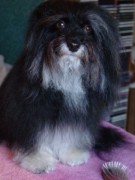 Unfortunately, the
combination of artificial heat, air-conditioning, dry atmosphere and static electricity may result
in coat damage or an assortment of skin problems. Spraying the coat with coat dressing,
conditioner or diluted creme rinse before brushing may help to prevent dryness and static
buildup and also adds a lovely sheen to the coat. For most pet grooming, a smooth tipped pin
brush or soft wire slicker brush will be the tool of choice. Choose a soft brush to avoid
scratching or irritating the skin. Many people use a pin brush to minimize coat breakage, and
reserve the slicker for grooming the feet or tangled areas only. You may use the slicker all over
if you wish but there will be some coat damage due to hair breakage. Which ever brush you
choose, brushing must be done thoroughly but gently. The most efficient method is line brushing
where the entire coat is brushed in layers from the skin out. This is usually easiest if the dog is
lying on its side. With one hand, the hair is parted to the skin and held down while the other
hand gently brushes through the hair below the part. Once this section is smooth and tangle
free, another section of hair is pulled down along the part and groomed in the same way. You
may need to moisten each layer with a light mist of conditioner or coat dressing before
brushing.
Unfortunately, the
combination of artificial heat, air-conditioning, dry atmosphere and static electricity may result
in coat damage or an assortment of skin problems. Spraying the coat with coat dressing,
conditioner or diluted creme rinse before brushing may help to prevent dryness and static
buildup and also adds a lovely sheen to the coat. For most pet grooming, a smooth tipped pin
brush or soft wire slicker brush will be the tool of choice. Choose a soft brush to avoid
scratching or irritating the skin. Many people use a pin brush to minimize coat breakage, and
reserve the slicker for grooming the feet or tangled areas only. You may use the slicker all over
if you wish but there will be some coat damage due to hair breakage. Which ever brush you
choose, brushing must be done thoroughly but gently. The most efficient method is line brushing
where the entire coat is brushed in layers from the skin out. This is usually easiest if the dog is
lying on its side. With one hand, the hair is parted to the skin and held down while the other
hand gently brushes through the hair below the part. Once this section is smooth and tangle
free, another section of hair is pulled down along the part and groomed in the same way. You
may need to moisten each layer with a light mist of conditioner or coat dressing before
brushing.
The Havanese have an abundance of hair around the face. If any food or dry matter have accumulated in the facial hair or beard, you should start your grooming session by working in some liquid tangle remover or conditioner into the soiled hair. During the time that it takes to brush the body, the tangle remover has a chance to soften and loosen the debris that was caked on, thereby making it much easier to remove.
With the dog laying on its side start by line brushing the front and hind legs on that side. Then proceed to line brush the body coat until you reach the backbone. Turn the dog over and repeat the procedure on the other side. If you prefer, you can also reverse this procedure by starting at the backbone and working down to the legs. You may find one way easier than the other. The order does not really matter so long as all parts of the dog are brushed and combed thoroughly. The chest and stomach area can be reached by lifting the dogs front leg or by rolling it onto it's back. Finally, with the dog sitting or standing, brush the head, chest, neck, top of body and the tail. Unlike many other long coated breeds, the Havanese coat should not be artificially parted in a perfect straight line along the spine. Rather, you should allow the coat to fall on its own. A long, heavy or profuse coat may part naturally. Comb out the face, corner of the eyes and beard, using the teeth on the fine end of the comb or use an extra-fine facial or flea comb. If the beard was pre-treated with tangle remover , it should comb out easily. After the hair has been completely brushed ; take the medium/coarse end of the comb and run it through the coat to make sure that all mats and tangles have been removed. If your Havanese has a curly coat you may find it easier to use a wide tooth poodle comb. Any mats or tangles that you encounter should be saturated with conditioner then teased out gently rather than pulled or cut out. You have a few options for what to do with the head furnishings. The hair may be simply brushed back and allowed to fall naturally or it may be parted in the centre and then combed to the sides or braided into a single plait on either side; creating a lovely frame for the bright eyes and endearing expression. Other options are to gather up the hair into a simple topknot or to fasten it back with barrettes or small clips. On a pet only, you may choose to trim the fall to a shorter length.
Cleaning the eyes and ears 
Gently bathe the skin around the eyes using a moistened cotton ball or soft wash cloth. White or light-coated Havanese may get discoloured hair near the eyes and mouth. Daily cleaning will help control this staining. A soothing eye lotion (available from your vet or pet supply store) helps to ease eye irritation. A few drops applied to the stained area may help to neutralize and remove the discolouration. Assorted grooming products from your pet store or groomer are also available to camouflage the staining. See your Vet for other treatments for this problem if it is severe or very unsightly. Excess tearing and subsequent staining can also be due to all the minerals and other impurities found in tap water. Switching to filtered or distilled water in the water dish can make a dramatic difference. It can take up to 3 months to see the best results but improvement may be noted in as little as a few weeks.
As with all dogs with heavily feathered long pendant ears, problems can arise if the ears of your Havanese are not cleaned regularly. Hold open the ear with one hand and gently clean inside the ear flap with a moistened cloth or cotton ball. Do not probe too deeply inside the ear canal. The hair growing inside the ear should be regularly plucked out, a few hairs at a time using your fingers, tweezers or a haemostat. It is important to use a fresh cotton ball or a clean corner of the wash cloth for each eye and ear.
Cleaning the teeth 
Just like human beings, dogs teeth accumulate plaque which can harden into tartar. If the teeth are neglected, bacteria can grow causing infections. Regular brushing can help to maintain a dogs teeth and gums as well as keeping the breath fresh. You should brush the teeth 2-3 times a week. If you start at a young age by scratching the muzzle and handling the mouth you should soon be able to rub the teeth and gums with your finger. Then you should be able to easily progress to gently brushing the dogs teeth with a small soft toothbrush or finger brush. Never use human toothpaste as it contains detergent which will froth in the dog's mouth and, if swallowed, may upset the stomach. A better alternative is to use a canine toothpaste. This special enzymatic toothpaste is available from your veterinarian or pet supply store in an assortment of palatable flavours like chicken, liver and malt.
Trimming the nails 
The nails will grow too long if left unattended. Most dogs
hate to have their
nails clipped, but if
you start when the dog is young he should learn to accept it as part of
the
grooming routine. 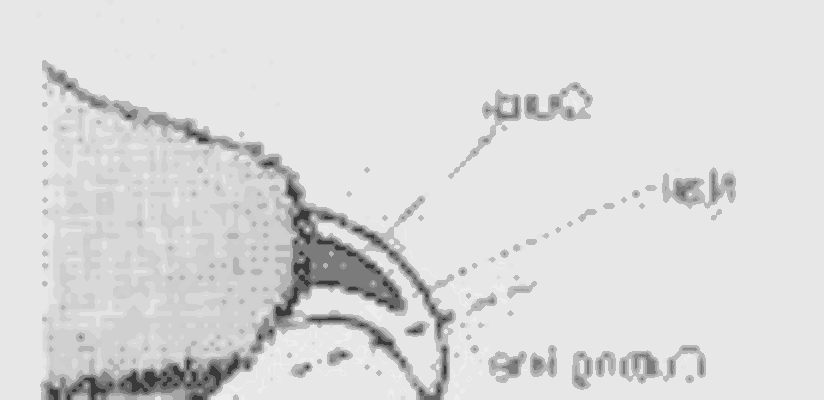 Clip the nails carefully, a little at a time, taking
care not to cut the quick. Then smooth
any rough edges with an emery board or nail file. If you are having great difficulty with this
task, you may need to see your groomer or Vet for regular nail care.
Clip the nails carefully, a little at a time, taking
care not to cut the quick. Then smooth
any rough edges with an emery board or nail file. If you are having great difficulty with this
task, you may need to see your groomer or Vet for regular nail care.
Bath Day
Your Havanesewill get dirty and need a bath from time to time. Dogs like Havanese that are generally allowed on the furniture and bed are usually bathed quite regularly; perhaps once a month for a pet Havanese. You may choose to do this yourself or visit a professional groomer.
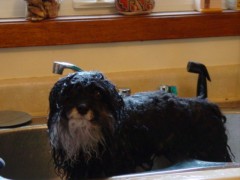
On the left is Rags having a bath at home in the kitchen sink. The sink works well for toy breeds like the Havanese. It keeps the dog at a good working height and is much easier than bathing in the tub and the sprayer is wonderful for wetting and rinsing.
On the right Rags is on the grooming table being fluff dried.
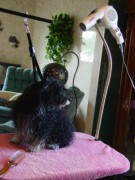
Pet clips
Besides the regular grooming and care that you do at
home, your Havanese may benefit from
the regular attentions of a professional groomer. Few owners choose to keep their pet Havanese
in the glorious full coat of the show dog. Many pet owners prefer a shortened coat to make the
dog easier to brush and maintain. You have a number of options available. The most popular
option is to have the coat clipped or scissored to a uniform length all over. Your groomer can
help you decide which length is best for you and your pet according to your grooming skills and
inclination as well as the appearance that you wish to maintain.
Do keep in mind that the coat is there for a reason. Tradition has it that the Havanese coat not
be
clipped, with exceptions for safety and cleanliness like hygienic trimming. Choosing to clip is a
personal choice, but before doing so, do consider the following
- The Havanese should never be shaved to the skin except in emergencies. There are groomers who wrongfully may tell you to shave your Havanese in summer to keep it cool. They may even do it without your consent! Dogs however do not sweat or keep cool like humans do. Their cooling process is done primarily by panting and sweating at the paws. The soft wavy coat of the Havanese acts as insulation trapping air next to the skin to keep the dog cool in hot weather as well as to keep it warm in colder weather. Just like insulation in your house. It keeps the house cooler in summer and warmer in winter
- If you shave the Havanese right down to the skin, you expose it to the sun with no protection whatsoever, leaving it vulnerable to glare, sun burn and a variety of potential skin disorders including skin cancer.
- A long coat also acts as protection against many insects and parasites. Think how much work a mosquito would have to do to find skin on a full coated dog compared to a shaved dog. The Havanese coat provides similar protection as wearing long loose clothing protects you.
- Constantly clipping or shaving a Havanese can alter the texture of the coat and change the natural balance of oils in the skin.
- Keep in mind that the more coat you cut off, the less your dog will look like a Havanese. If groomed regularly and carefully, a medium length Havanese coat should be quite manageable for most pet owners and provide many of the advantages the Havanese coat has to offer.
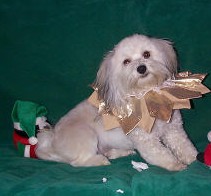
Noel was shaved down with clippers
into a velvety short clip about 1/2 inch
long. A little beard was left as well
as full feathering on the ears and tail.
Noel is the star of the Cain household.
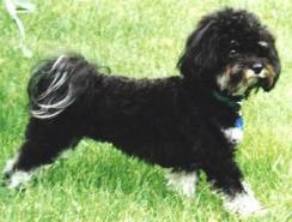
This photograph shows Rags sporting a
puppy clip where the entire coat was
trimmed down to about 1 inch. The ears
and tail were left fully feathered.
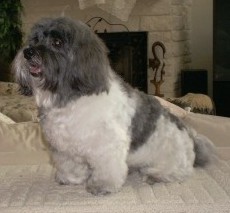 Murphy, owned by the Rhodes
Murphy, owned by the Rhodes family in Texas is cute, cuddly,
and easily maintained in a teddy
bear clip; scissored down to about
1&1/2 to 2 inches all over.
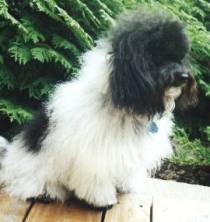
In this photo, Mitzi has an attractive
medium length coat about 3 inches
in length. Her face and feet have
been trimmed. As well, the shoulder
and rump area have been thinned
and tapered.
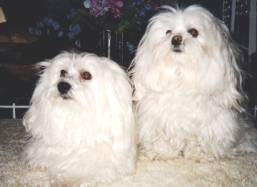
Here are Misty and B.J., a pair of pet
Havanese in untrimmed coats. Their
lovely medium length locks, about 4
inches long, have been allowed to grow
out naturally from shorter puppy clips.
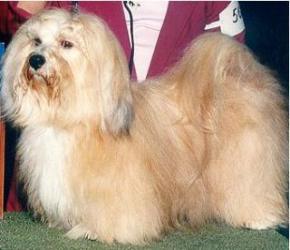
And finally, here is Pancho,
immaculately maintained in a glorious
full-length show coat. It can take up
to 3 years for a coat to fully mature
and may achieve a length of 6-8 inches
or longer.
More grooming information
Check out the Tidbits section for an assortment of grooming articles. For more complete grooming information, a good source is the grooming Handbook from the Havanese Fanciers of Canada From Nose To Tail
